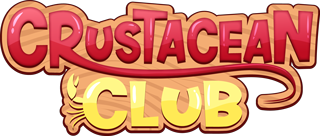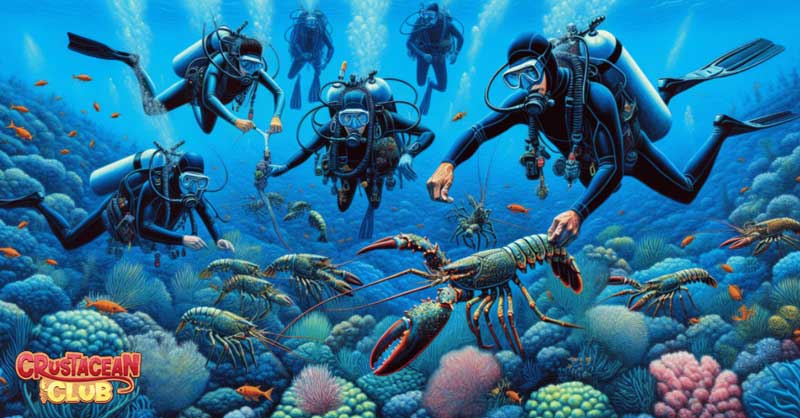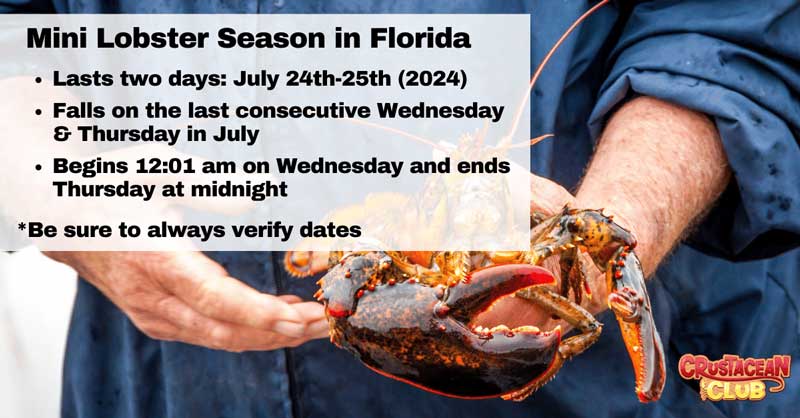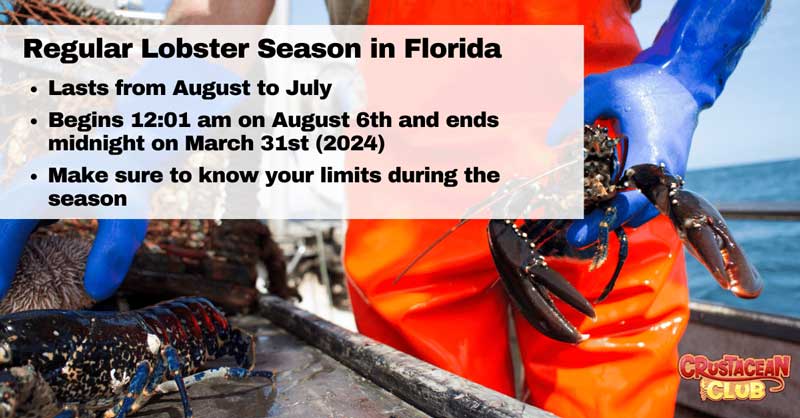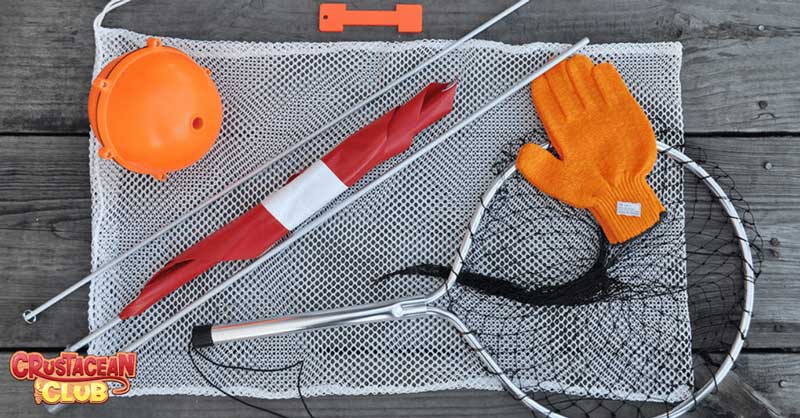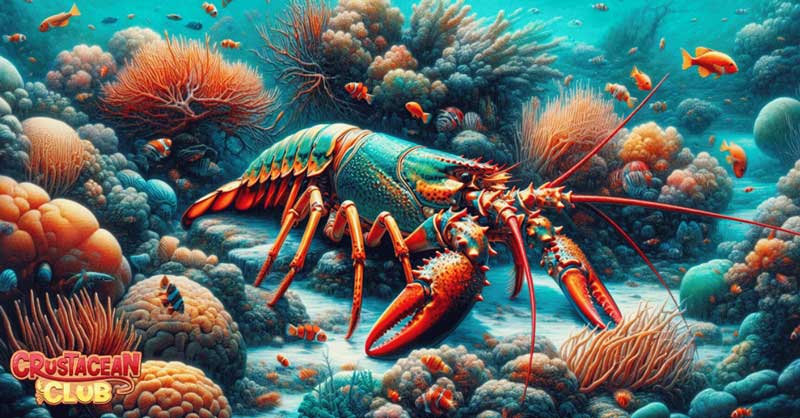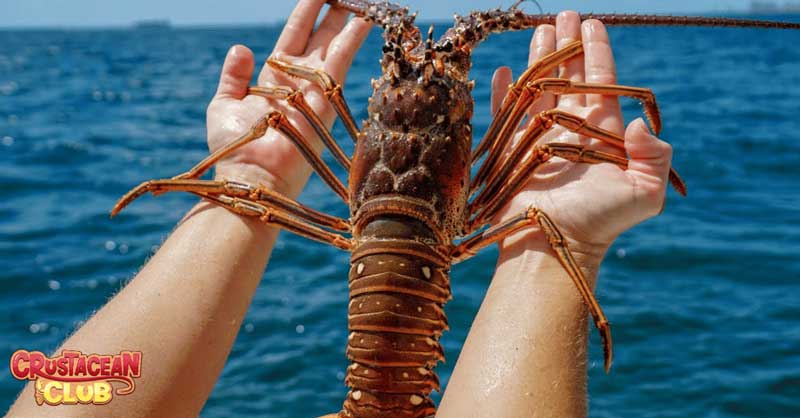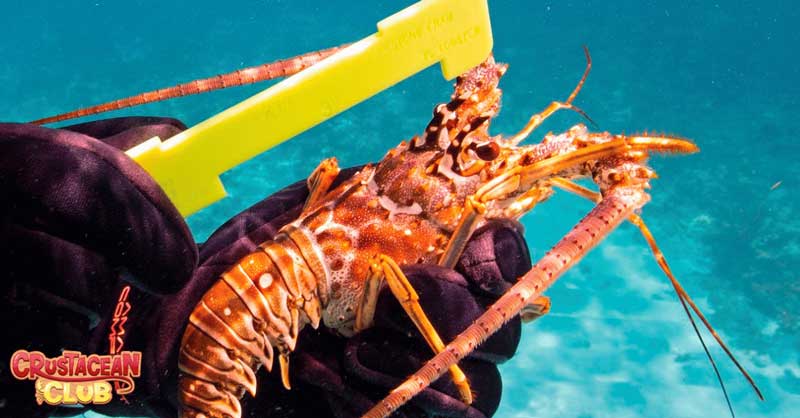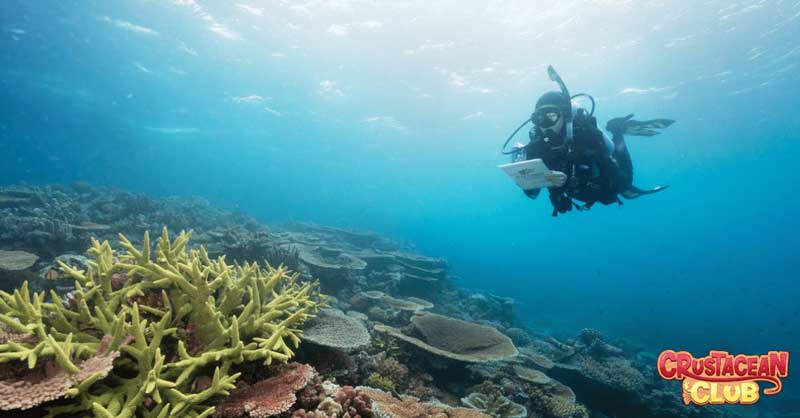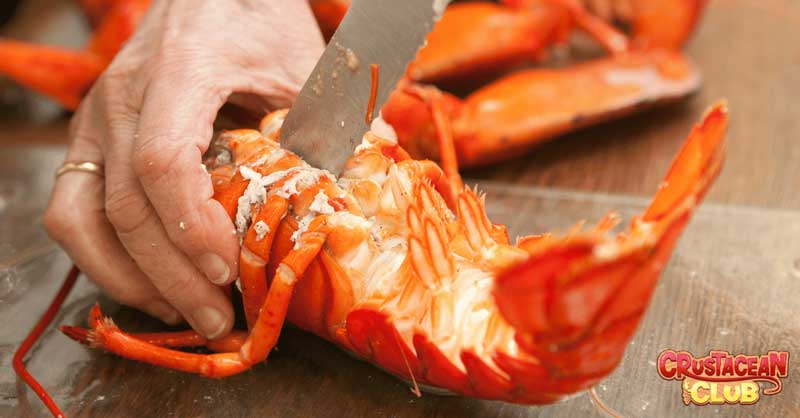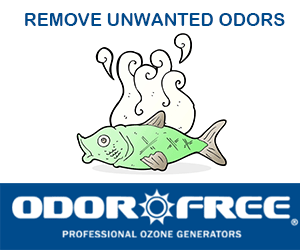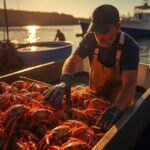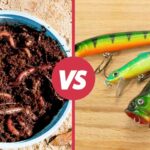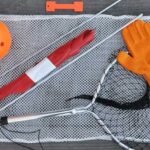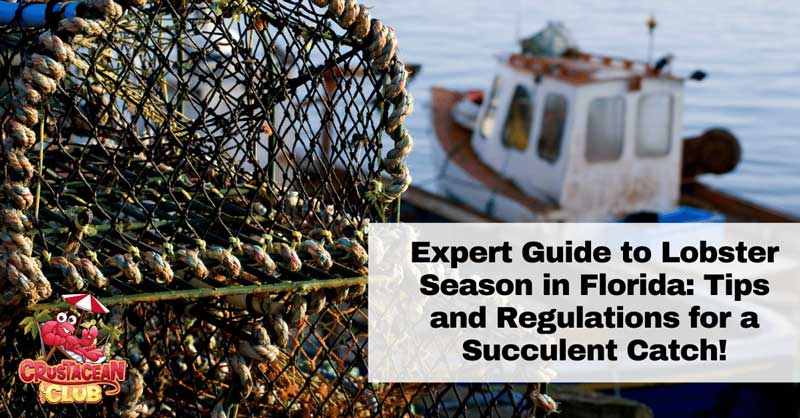
Wondering when you can embark on your next lobster hunting adventure in Florida? The lobster season in Florida unfolds in two parts: a short, intense mini-season typically in late July, and the regular season running from August 6th to March 31st. Ready to dive deeper? Our guide will navigate you through essential tips, regulations, and techniques for a bountiful and legal lobster catch.
For more information on all things crustacean, be sure to check out the Crustacean Club site where you can also find expert guides on lobstering and crabbing!
Key Takeaways
- Florida’s lobster season is split into two parts: a two-day mini season in July, and the main season from August 6th to March 31st, giving divers different experiences and ample opportunities to catch lobsters.
- Lobster divers must adhere to regulations such as measuring their lobster using a measuring gauge to ensure lobsters are of legal size, and follow bag limits to promote sustainability of the lobster population.
- Safety and respect for the marine environment are crucial in lobster diving, involving proper gear, recognizing protected areas, and careful handling of egg-bearing female lobsters. Learn more about safety and regulation with our guide on the mastering the art of lobstering!
We love hearing from our readers and subscribers, so please feel free to reach out and contact us today!
Unlocking the Secrets of Florida’s Lobster Season
Florida’s lobster season, a time of year many seafood lovers eagerly await, is a unique two-part saga. It opens with a brief but thrilling mini season that whets the appetite of Florida lobster divers, followed by the longer and equally rewarding regular lobster season.
Whether you’re a seasoned lobster hunter or a novice hoping to haul in your first catch, understanding the rhythm of the season is key to maximizing your lobster trips and ensuring your harvest is as plentiful as it is legal.
Mini Lobster Season: A Two-Day Spectacle
The mini lobster season, a two-day extravaganza typically held on the last consecutive Wednesday and Thursday of July, is a whirlwind event that sees recreational divers racing against time and each other. It’s a brief window of opportunity to catch lobsters before commercial operations deploy their fishing nets, marking an exciting kickoff to the spiny lobster season.
But as the seas teem with eager lobster divers, it’s vital to remember that safety comes first. Over the past decade, there’s been an average of two diving fatalities each season. The excitement of the mini season should never overshadow the importance of safety precautions. This year the mini season falls on July 24th and 25th. Make sure to always verify dates and regulations with Florida Fish and Wildlife. It begins at 12:01 am on Wednesday and ends at 12:00 midnight on Thursday.
So, how can you safely enjoy the mini season while maximizing your catch? The secret lies in preparation. Here are some steps to follow:
- Familiarize yourself with the local regulations.
- Ensure your dive gear is in top-notch condition.
- Plan your dive to avoid the peak hours when accidents are most likely to happen.
By following these steps, you can have a safe and successful mini season. And remember that during the mini-season, diving at night is prohibited in Monroe County. Keep your lobster hunting limited to the daytime.
Regular Lobster Season: Duration and Details
As the frenzy of the mini season subsides, the regular lobster season takes over, providing a more sustained opportunity for lobster diving. Spanning from August 6th to March 31st, the regular season allows both experienced and novice divers ample time to experience the thrill of hunting for Florida’s spiny lobsters.
During this period, the waters of Florida, including the beautiful Florida Keys, turn into a playground for lobster hunters and Florida fish enthusiasts alike. Whether you’re out for a personal challenge, or simply want to enjoy a unique adventure, the regular season offers a rewarding experience that combines the thrill of the hunt with the joy of a delicious catch!
Essential Gear for Successful Lobster Diving
Going lobster diving is like going on a treasure hunt – you need the right tools to strike gold. In this case, the ‘gold’ is the spiny lobster, and the tools include a saltwater fishing license, a lobster stamp, and a measuring gauge, among others.
The measuring gauge is especially crucial, as it enables you to ensure that your catch complies with the legal size limit. Remember, a legal lobster must have a carapace length of at least three inches, and undersized lobsters must be immediately released back into the water. This not only ensures that you’re following the law, but also helps sustain the lobster population for future seasons.
Despite the excitement of the hunt, it’s crucial to remember that traps are prohibited for recreational lobster fishing in Florida. Lobsters must remain whole while in state waters. So equip yourself with a handy tickle stick and a net, and prepare to dive in!
Navigating the Waters: Where to Find Spiny Lobsters
Knowing where to find spiny lobsters is half the battle won. These elusive creatures are often found around coral reefs and rock outcroppings, with popular locations extending from Key West’s vibrant coral reefs to the ledges off Jacksonville Beach in the Atlantic waters. But remember, navigating these waters requires not just knowledge, but respect for the marine environment.
Certain locations like Hawks Cay Resort in the Florida Keys are renowned for directing divers to prime lobster spots during the lobster season. But it’s also crucial to be aware of the protected areas where lobster harvesting is heavily regulated or prohibited, such as Everglades National Park, Dry Tortugas National Park, and the Florida Keys National Marine Sanctuary.
Moreover, special regulations apply during both the mini season and regular season. Areas like John Pennekamp Coral Reef State Park, the Biscayne Bay/Card Sound Lobster Sanctuary, and the Biscayne National Park Coral Reef Protection Areas have specific prohibitions in place. So, always check the local regulations before you set out on your lobster hunting expedition.
The Art of Catching Spiny Lobsters
Catching a spiny lobster isn’t just about diving in and hoping for the best. It’s an art that requires patience, skill, and a little bit of finesse. The primary tool? A tickle stick – a thin rod about three feet in length with an angled tip that can reach into the lobster’s hiding spot.
Here’s how it works:
- You insert the tickle stick into the hiding place, gently tickling the lobster’s tail.
- This encourages the lobster to emerge, allowing you to grab it by the midsection.
- It may take a few tries, but with patience and practice, you’ll get the hang of it.
Once the lobster is coaxed out of its refuge, you can use a net to capture it efficiently. But remember, not all lobsters are fair game. Egg-bearing female lobsters, identified by the egg masses under their tails, are protected by law and must be released unharmed. It’s all part of the delicate balance of preserving the marine life and enjoying the sport.
So, with tickle stick in hand and a sense of respect for the marine life, you’re ready to dive in and experience the thrill of catching your first spiny lobster!
Understanding Bag Limits and Size Restrictions
Bag limits and size restrictions are essential tools in ensuring the sustainability of the lobster population. In Monroe County, a hotspot for lobster hunters, the daily bag limit is six lobsters per person. This means that while on the water, you cannot possess more than six lobsters at any time.
Once off the water, the possession limit equals the daily bag limit on the first day. Then, it doubles on the second day. These regulations are in place to prevent overharvesting and ensure that individuals do not exceed the legal amount of lobsters over a multi-day period.
Remember, the goal is not just to catch as many lobsters as you can, but to enjoy the experience while respecting the rules that help protect and preserve the lobster population. So, always measure your catch and stick to the bag limits!
Preserving Marine Life: Do’s and Don’ts
As lobster divers, we have a responsibility towards preserving the marine life that provides us with such thrilling adventures. Practicing safe boating is a crucial part of that responsibility. This means:
- Avoiding anchoring on coral
- Using mooring buoys or sandy bottoms for anchoring when necessary
- Taking free online boating courses to hone your seamanship skills
Respecting the no-take areas is another critical aspect of conservation. These areas are designated to protect certain habitats and species, and it’s essential to comply with the regulations that govern them. Remember, the goal is not just to catch lobsters, but to do so in a way that doesn’t harm the marine ecosystem.
Finally, be sure to release egg-bearing female spiny lobsters if you accidentally catch them. These females, easily identified by the bright orange eggs under their tails, are crucial for sustaining the lobster population as female lobsters carry eggs. By releasing them, you’re playing a part in ensuring that future generations can enjoy the same thrilling experience of lobster diving.
Dive Safety and Etiquette in Lobster Season
Dive safety and etiquette are paramount in ensuring not just a successful catch, but also a safe and enjoyable diving experience. Before you embark on your lobster hunting adventure, check your dive gear for functionality and refresh your diving skills.
Recognizing personal limitations is another key aspect of dive safety. Here are some tips to keep in mind:
- Avoid pushing beyond your comfort levels
- Remember, you have the right to call off a dive at any point if you deem it necessary for safety
- Following the advice of Divers Alert Network (DAN), always prioritize safety over the thrill of the hunt.
During the mini lobster season, keep in mind that snorkeling or diving within 300 feet of residential or commercial shorelines is prohibited, and night diving is not allowed. Adhering to these regulations ensures a safe and respectful diving experience for all.
Preparing Your Palate: From Catch to Kitchen
After a successful catch, it’s time to savor the fruits of your labor. Preparing a spiny lobster is a culinary adventure in itself! Whether you’re grilling, boiling, or incorporating the lobster meat into a recipe, the succulent taste of fresh-caught lobster is a reward worth savoring.
Classic methods of preparation include grilling with a mix of butter, garlic salt, chives, and parsley, or boiling in water seasoned with Old Bay. The cooked meat can be enjoyed as is, served with herb-infused butter and a squeeze of lemon, or incorporated into a variety of dishes.
From lobster mac and cheese, featuring cooked lobster mixed into a rich sauce of Gruyere and cheddar, to enchilado de langosta, where the lobster is sautéed with vegetables and spices, the possibilities are endless. So, don your chef’s hat and get ready to indulge in a feast fit for a king with our endless list of recipes!
Summary
From understanding the rhythms of Florida’s lobster seasons, equipping yourself with the right gear and knowledge, through the thrilling pursuit and careful capture, to the final act of cooking and eating your catch – lobster diving is truly an adventure of a lifetime. It’s a journey that combines the thrill of the hunt with the joy of a delicious feast, all while respecting and preserving the marine life that makes it all possible. So, what are you waiting for? Dive in and join the adventure!
Learn more about us and the wealth of knowledge we have to offer here at Crustacean Club about all things, well, crustacean!
Frequently Asked Questions
When is the mini lobster season in Florida?
The mini lobster season in Florida happens on the last consecutive Wednesday and Thursday of July each year. Mark your calendars!
What is the daily bag limit for lobsters in Monroe County?
You can catch up to six lobsters per person daily in Monroe County. So, make sure to keep that limit in mind when you’re out lobstering.
What is a tickle stick and how is it used?
A tickle stick is a thin rod used to gently coax lobsters out of their hiding spots by tickling their tails, making it easier to capture them.
What are some popular locations for finding spiny lobsters in Florida?
You can commonly find spiny lobsters around coral reefs and rock outcroppings, with popular locations including Key West’s coral reefs and the ledges off Jacksonville Beach in the Atlantic waters.
How can I cook a spiny lobster?
You can cook a spiny lobster by grilling, boiling, or using it in recipes like lobster mac and cheese or enchilado de langosta. It’s all about personal preference and what you’re in the mood for!
Hi! My name is Jessica, and I am the Head of Content for Crustacean Club. If you woul like any changes or if you want to submit a blog, DM me!
